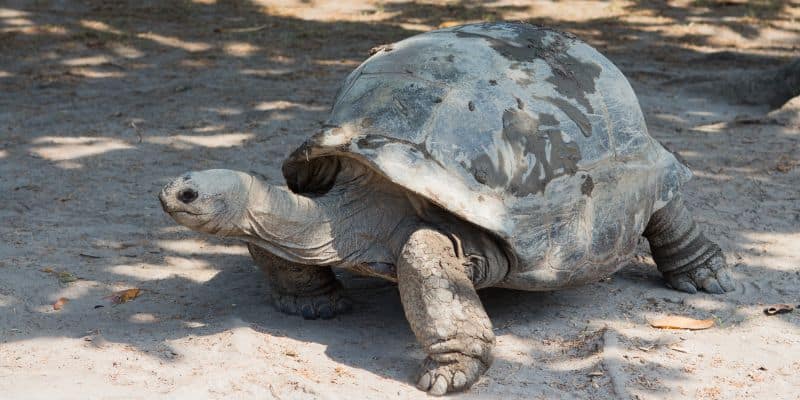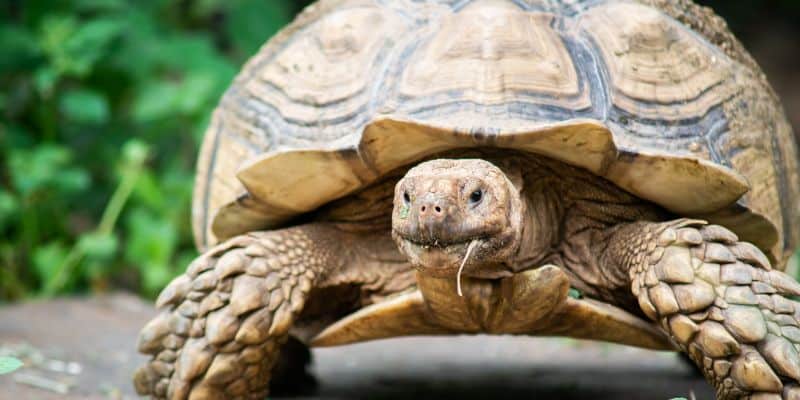Slow-moving and unbothered by the world around them, giant tortoises are undeniably charming. I have my own childhood memories of the giant tortoise living at my local pet store—a creature that is probably still alive today.
Social media has allowed people from all over the world to experience the intrigue of giant tortoises. It’s no surprise that interest in owning one of these gentle behemoths has skyrocketed.
This article covers all of the hot topics surrounding giant tortoise pet ownership, including whether or not owning a giant tortoise is even legal. You’ll learn what it takes to rear a healthy giant tortoise and a few reasons why you probably shouldn’t adopt one yourself.
Understanding Giant Tortoises
We don’t have an official definition of what makes a tortoise ‘giant’. There are several species capable of reaching impressive sizes that are colloquially known as giant tortoises.
Perhaps the most famous species alive today is the Galápagos tortoise (Chelonoidis niger). The Galápagos tortoise is the largest species of tortoise in the world—it does have some larger, extinct ancestors—and can weigh over 900 pounds at maturity.
In the wild, Galápagos tortoises easily live over 100 years. Captive specimens are known to live 175 years or longer with proper care. All Galápagos tortoises are native to the Galápagos Islands located off the coast of Ecuador.

The second-largest species alive today is the Aldabra tortoise (Aldabrachelys gigantea). These tortoises are endemic to the Seychelles Islands in the Indian Ocean.
Despite being #2 in the tortoise world, Aldabras only weigh about half as much as the Galapagos tortoises. Aldabra tortoises typically live up to 120 years in the wild, with domestic tortoises living up to 150 years.

The last giant tortoise we’ll be focusing on is the Sulcata tortoise, also known as the African spurred tortoise (Centrochelys sulcata). The average Sulcata tortoise weighs 70 to 100 pounds at maturity—quite a bit less than the other giant tortoises!
Sulcata tortoises come from North Africa, with most populations being native to the Sahara Desert and the adjoining Sahel Region. The Sulcata tortoise lifespan isn’t well-recorded, but we know most Sulcatas can live 70 years or longer with the right conditions.
Natural Habitat and Behavior
All giant tortoises tend to thrive in relatively arid climates, with the Sulcata tortoise being the most well-adapted to desert-like conditions. Even the Galápagos tortoise, which is typically thought of as a tropical species, prefers to live in the driest parts of the Galápagos Islands.
Giant tortoises are natural grazers, spending the vast majority of their time slowly moving across the landscape and consuming plant matter. The diet of a giant tortoise is very low in nutrition, so these beasts must eat a lot of vegetation to meet their dietary needs.
Due to their sheer size and protective shells, giant tortoises have few (if any) natural predators. Humans are by far the greatest threat, followed by concerns like disease and habitat destruction.
Legal and Ethical Considerations
At this point, there’s a huge question looming over us: Is it even legal to own one of these giant tortoises? The answer is that it depends.
The Galápagos tortoise is a beautiful, fascinating creature that I think everyone should get to see at least once in their life. However, it is far from an appropriate pet.
In the U.S. (and most other countries), it is illegal to own a Galápagos tortoise unless you have a special permit allowing you to care for endangered wildlife. Even if you do have one of these permits, Galápagos tortoises are illegal to buy and sell. In rare cases, domestic Galápagos tortoises come from conservation breeding programs (for example, sometimes a captive-bred tortoise has health issues that make it impossible to be released into the wild as intended).
If you truly have your heart set on a giant tortoise, the Aldabra tortoise may be an option. Most regions allow you to own an Aldabra tortoise without a special permit. Note, though, that the legal Aldabra tortoise trade is very limited. In the U.S., where tortoises are fairly popular as pets, there are only a handful of ethical Aldabra breeders.
I strongly encourage anyone interested in owning a giant tortoise to consider the Sulcata tortoise. Not only are these tortoises legal to own and more easily sourced than the Aldabra tortoise, but they are also the easiest to care for.
Ethical Considerations
Of course, legality is just one side of the question. There are also ethical concerns regarding owning a giant tortoise.
Most tortoise enthusiasts agree that any tortoise that is legal to own AND ethically sourced is a suitable pet. Some go a step further, however, and believe that it’s impossible to give a giant tortoise the life it deserves in captivity.
In my opinion, the biggest factor in this debate is whether or not a tortoise is ethically sourced. The illegal pet trade has decimated wild populations of many species, pushing some to the brink of extinction.
Both the Aldabra and the Sulcata tortoise are currently listed as Vulnerable in the wild. According to the Galapagos Conservancy, Galápagos tortoises are listed as Critically Endangered.
Housing and Space Requirements
Giant tortoises must almost exclusively live outdoors. They need lots of space to roam, dig, and sunbathe. It’s also very hard to replicate the ideal climate for any of these tortoise species indoors.
An outdoor enclosure should be well-fenced—both above and below. Many tortoises are adept climbers, so I recommend a fence that measures at least 24 to 30 inches tall. To keep your giant tortoise from burrowing under the enclosure fence, be sure to extend the barrier up to a foot underground as well.
Again, these creatures need a lot of space. A mature giant tortoise should have around 2,500 square feet (or more!) at its disposal. In other words, you need a well-sized yard or garden to adequately house a giant tortoise.
Young tortoises need proportionally less space. A juvenile tortoise (one that is about one-third of its full size) can thrive with around 1,000 square feet. Baby tortoises should be given an enclosure measuring a couple hundred square feet that expands to match their growth.
Time and Financial Commitment
Owning a giant tortoise is a big commitment—arguably more than that of owning something like a cat or dog. A giant tortoise will live for several decades or longer, so you need to think carefully about what your lifestyle will look like in the distant future. There are also times when a tortoise outlives its owner and arrangements must be made to ensure the animal continues to receive adequate care.
That’s the big picture. But what does day-to-day life with a giant tortoise look like?
While your pet tortoise won’t need long walks or dedicated playtime, caring for a giant tortoise still requires several hours per week. You need to prepare fresh food, clean the tortoise’s enclosure, and spend time taking care of its overall health.
Of course, this all comes at a financial cost as well. Since things like vet bills can vary greatly by location, I won’t get into the details here. I recommend reaching out to other local tortoise owners when setting up your personal pet care budget.
Are You Starving Your Tortoise?
Save 10% on premium tortoise food and supplements from Tortoise Resource Center on Amazon now using code BUYNOWGET10

Sulcata Vitamin & Mineral Topper Supplement
30-Day Supply | 2 oz (56 g)
$24.99

Baby Sulcata Tortoise Superfood Powder
30-Day Supply | 2.5 oz (70.8 g) Bag
$24.99
Pros and Cons of Owning a Giant Tortoise
A giant tortoise certainly isn’t the right pet for everyone. But if you have the time, space, finances, and dedication needed to care for one of these magnificent giants, it can be a life-changing experience.
Pros
- Giant tortoises can be lifelong companions
- They are a unique pet that will start many conversations
- Each tortoise has its own temperament and personality
- Giant tortoises are perfectly content to be left alone for long periods (as long as their needs are being met)
Cons
- Owning a giant tortoise is a lifelong commitment
- Veterinarians who treat giant tortoises are rare and costly
- Giant tortoises need a TON of space
- Ethical, captive-bred tortoises are expensive and difficult to find
- Not all regions are warm enough for tortoises to live outdoors
Citations
- VICE We Asked Giant Tortoise Owners: Why?
- The Turtle Room Convention on International Trade in Endangered Species of Wild Fauna and Flora (CITES)
- The Orianne Society Aldabra Giant Tortoise
- Galapagos Conservation Galápagos Giant Tortoise


